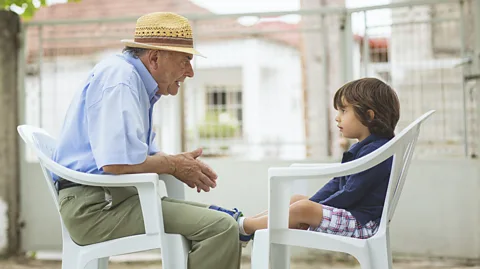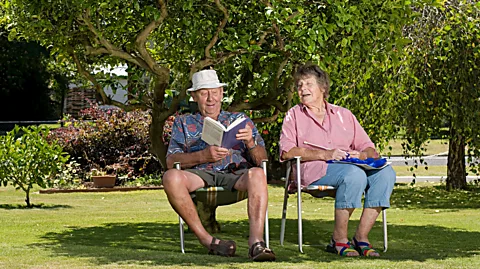Sit-to-stand: The simple test that reveals how you're ageing
 Getty Images
Getty ImagesThe sit-to-stand test takes just 30 seconds to complete, but its results can provide profound insights into your health.
Getting out of a chair may seem too trivial a task to pay much attention to, but your ability to do so actually reveals a great deal about your health. To assess this, doctors use the sit-to-stand test (STS), which measures how many times you can rise to a standing position from seated within 30 seconds. It's commonly performed in GP surgeries, or community settings when screening for health issues amongst older people, but it can also easily be performed at home.
"It's a really helpful test, because it tells us so much about how well people are functioning," says Jugdeep Dhesi, a consultant geriatrician at Guy's and St Thomas' NHS Foundation Trust in London and professor of geriatric medicine at Kings College London, in the UK. "It tells us about their strength, their balance and their flexibility. We know that there's some studies that suggest that it can help to inform whether people are at risk of things like falls, cardiovascular issues or even at a higher risk of dying."
All you need to do the test at home is a chair with a straight back and no arm rests, and a stopwatch or timer (most modern phones have this function).
More like this:
To do the test, simply sit in the middle of the chair, cross your arms and place both of your hands on opposing shoulders. Keep your back straight with your feet on the floor. Then press your stopwatch's start button and rise to a full standing position before sitting down again. Repeat this for 30 seconds, counting how many times you can come to a full standing position.
 Getty Images
Getty ImagesWhile the test is primarily used in older adults over the age of 60, it has also been used in those who are younger.
The US public health agency the Centers for Disease Control and Prevention (CDC) has outlined the average results for different age groups. Scores which are below the average could indicate a risk for poor health outcomes, such as falls. For example, for a person aged between 60-64, the average is 14 for a man, and 12 for a woman. If you are aged 85-89, however, the average score is eight. However, these average scores do not take into account a person's medical history – for example if they have recently undergone surgery or have an injury.
Find out how you compare
According to the CDC, the average STS test scores for each age group are:
• 60-64 the average score is 14 for men, and 12 for women
• 65–69 the average score is 12 for men, and 11 for women.
• 70-74 the average score is 12 for men, and 10 for women.
• 75–79 the average score is 11 for men, and 10 for women.
• 80–84 the average score is 10 for men, and 9 for women.
• 85–89 the average score is 8 for both, men and women.
• 90–94 the average score is 7 for men, and 4 for women.
The test can also be beneficial for younger people or those with no health conditions, as it is a good measure of fitness, particularly lower body muscular strength and endurance. Researchers in Switzerland asked almost 7,000 adults to do the STS test and then compared the results. They found that the average score for 20–24-year-olds was 50/minute for men and 47/minute for women. Some of those taking part, however, were able to perform as many as 72 repetitions in a minute.
In another study of healthy volunteers, who had an average age of 21, researchers found a strong association between the results of the sit-to-stand test and a different – but more time-consuming – measure of their aerobic capacity and endurance.
Research shows that how well you perform on the test can also tell healthcare providers a great deal about your underlying health. For example a low score on the test can be used to identify people who might be at risk of worse outcomes after surgery or after cancer treatment.
A poor score on the test also suggests that a person's heart and lungs may not be functioning well, putting them at higher risk of "adverse cardiac events" such as myocardial infarction (heart attack), stroke and heart failure.
According to the Centres for Disease Control and Prevention (CDC), if a person scores less on the test than the "average" for their age group then they are also at greater risk of falls.
"What we're really worried about is that if people don't maintain their strength, their balance, their flexibility and their cardiovascular health, then they're more likely to fall," says Dhesi.
About 30% of people aged over 65 have a fall every year, and that rises to about 50% in people aged over 80 years. Once people have had one fall, they often become scared of falling again, making them less likely to go out, sometimes leading to social isolation.
"If you're worried about falling, you're not [necessarily] going to go out and meet people and do other things. So it becomes a bit of a vicious circle," says Dhesi.
 Getty Images
Getty ImagesAs well as social isolation, falls can cause significant injuries, especially in older people. "Falls are a really big issue, because as well as minor injuries, muscle tears and sprains, there is a risk of significant injuries like hip fractures," says Dhesi. In the US more than 300,000 people each year suffer hip fractures. "We know that there are 70,000 hip fractures a year in the UK and around 30% of people will die within a year of a hip fracture," says Dhesi.
One 2012 study even found that a variation of the STS test was a "significant predictor of mortality" of adults aged between 51 to 80. Individuals who scored low on the test were between five to six times more likely to die over a six-year period than those who scored highest. However, Dhesi points out that while tests like STS are a good indicator of health, they cannot predict how long a person can live.
"What you can use them [the sit-to-stand test results] to say is – this is something we need to think about, and there are treatments or interventions that we should be doing to try to improve a person's health outcomes, their quality of life, their independence and to help them to live well for longer, which is the really key bit," says Dhesi.
"Doing these kinds of tests at home helps you to see where you are in relation to other people of your age and so it can be a really useful prompt to remind you to do all the things that you can do to get better and stay better. So, I think it's a really good way of empowering people to take control of their own health."
 Getty Images
Getty ImagesHow to improve your performance
According to Dhesi, the best way of improving your score is to stay as active and mobile as possible. If mobility is difficult, you can start by doing seated exercises that can be used to build up strength. From there, you could move to standing up perhaps five times every hour or two hours.
If you are able, simply walking up and down your living room and making sure that you are going up and down the stairs at least three or four times a day can also make a difference.
"You want to avoid 'bungalow legs' [i.e. weak legs from living in a single-storey home] – essentially you want to make sure you can carry on going up and down stairs using those muscles, maintaining your balance, and remaining independent," says Dhesi.
Dhesi also advises people to go out and join exercise classes if they can. Many gyms run exercise programs for seniors at low cost.
"The added benefit there is the social contact on top of the physical contact. And we know that that's a really important aspect of as you get older – loneliness and social isolation can really be detrimental for your health."
Finally, other tips include keeping moving and doing housework. For older adults, playing with your grandkids if you have them – getting down on the floor with them, and getting up off the floor with them – can be helpful. Other recommendations include adding simple activities to your day-to-day routine such as getting up and stretching if you've been sat down for a while, walking to the shops instead of driving, or doing more gardening.
--
For trusted insights into better health and wellbeing rooted in science, sign up to the Health Fix newsletter, while The Essential List delivers a handpicked selection of features and insights.
